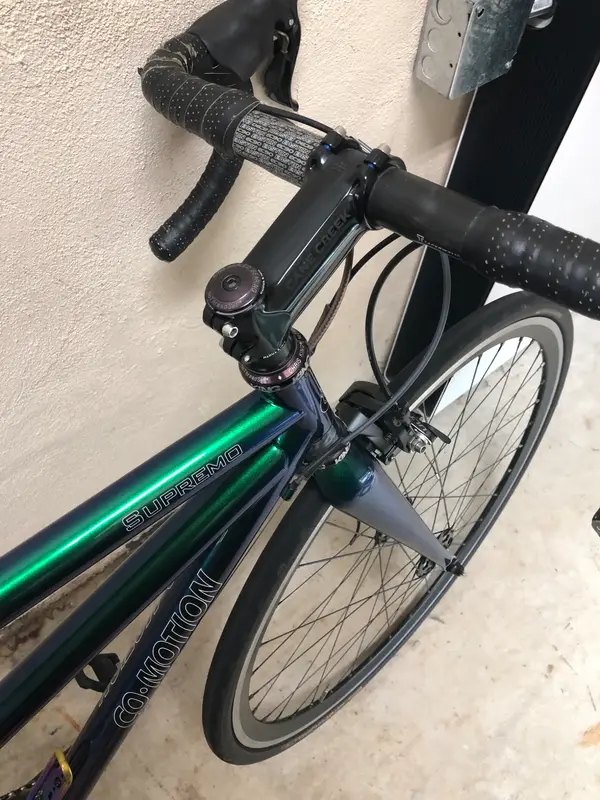OK, it's not because of hardening of the 7005 material.
That's already done and finished soon after the frame was built. Additional time barely increases tensile strength etc
Manufacturers will usually carry out an artificial age cycle post-weld (Put it in an oven, 10hrs @ 150°C, or similar) to drive a consistent ageing result. However, 7005 will also naturally age harden at room temperature (20°C) over a few weeks post-weld, so heat treatment is not strictly necessary, just advisable for business insurance/quality control/traceability etc. After ageing (natural or artificial), you need a lot more than warmish climate temps to make any difference to the alloy.
View attachment 953628
However, there are a number of other factors that do lead to the tendency of 7005 head tubes to crack, and it is rarely to do with riding stresses or accident damage.
Firstly, aluminium alloys are roughly 70% less elastic than steel (Modulus of Elasticity + Poisson Ratio); they react less well to the stresses of press fitting. The published standard tolerances for the headtube/headset fit were devised for steel frames. These were followed by the aluminium frame manufacturers without any adaptation for the characteristics of the new material. Consequently, aluminium frames experience higher localised stresses than the material should have.
Here's the published Hope specs for their 1-1/8" cups: 34.10mm +0.05/-0.00, headtube bore 33.90mm +0.05/-0.0, so 0.25mmØ max interference, 0.15mmØ minimum.
View attachment 953607
Eventually, the integrated headset system was developed for specifically aluminium frames to bypass the problem. No press fit, and a 45° tapered contact, but they did have their own new problems, so aren't universally popular, especially with carbon fibre frames.
Here (from Cane Creek), you can see that the more modern 'Semi-Integrated' systems, although still press-fit, have a far lighter fit tolerance (Max 0.15mmØ / Min 0.05mmØ) than the older 'Standard' cup tolerances.
View attachment 953617
Secondly, since they are chunkier than most of the other frame tubes, 7005 headtube blanks tend to be machined from thick-walled extruded tubing, rather than cold-drawn seamless tube (CDS). The grain structure in such extrusions is coarser, which gives less elasticity, lower tensile strength and fewer grain boundaries to share the stress across. This leads to higher localised stresses at grain boundaries, and a tendency to initiate cracks easier than CDS of the same alloy and dimensions.
Being a far more common alloy, especially in the US, 6061 is more easily available with thicker walls in CDS material, so head tubes on 6061 frames are often the finer-grained CDS material, so less prone to such failures.
Thirdly, some manufacturers reamed their headtubes to the tighter end of the published tolerances or beyond. Maybe intentionally, or just well-worn or re-ground tools? They often also failed to cut the specified chamfer on the internal edge of the headtube, which would have relieved a little stress at the tube ends and reduce the rsk of damage while pressing the cups in.
Fourth, some manufacturers (Notably Manitou and Pace) anodised their frames. The anodising produces a thin, hard but brittle surface, which cracks easily under the tension of a press-fit. These micro-cracks help the initiation of cracks into the softer main material of the tube. In the right light, these micro-cracks are readily visible in other tension places on anodised parts, such as handlebar stems, seat tube clamps and rim spoke holes.
Fifth, several high end headset manufacturers (notably Chris King and Hope, in my experience) make their headset cups right up at the fatter end of the standard tolerances. This combined with a tight-end spec frame can lead to far higher bursting stresses than the material can happily cope with.
Sixth, most headset manufacturers do not put a stress relief groove into their cups. This was common among older Campag and Japanese headset cups, Tange etc. This groove removes the direct bursting stress from the ends of the head tube, where cracks must initiate. End stress is reduced by 30-40% by this procedure. AFAIK Wolftooth are the only current manufacturer to have a groove anything like this on their head cups, but they can easily be cut into cups by anyone with access to a lathe. It just needs to be a few mms wide, and deep enough to not contact the bore of the headtube:
View attachment 953604
Lastly, by the mid-90s, aluminium frame manufacturers were really pushing the limits of what was possible with enhanced alloys and heat treatments, such as Easton Vari-Lite and the various Scandium doped sets.
A Manitou HT is still one of the the lightest aluminium hardtail ever built, barely 1350g, so every gram was shaved, and inevitably, factors of safety were minimised.
Smaller cracks yours are readily repairable with care. Remove any anodising/paint, U-cut the crack inside to 50% depth, clean/degrease, weld with 5356 filler, U-cut crack outside back into clean metal no voids, clean/degrease, weld outside, file back to surface, ream and face to looser end of spec and cut the 0.5mm chamfer.
Larger damage, or anything near the original tube welds would require a new head tube. Doable, but quite a bit more involved.
All the best,
